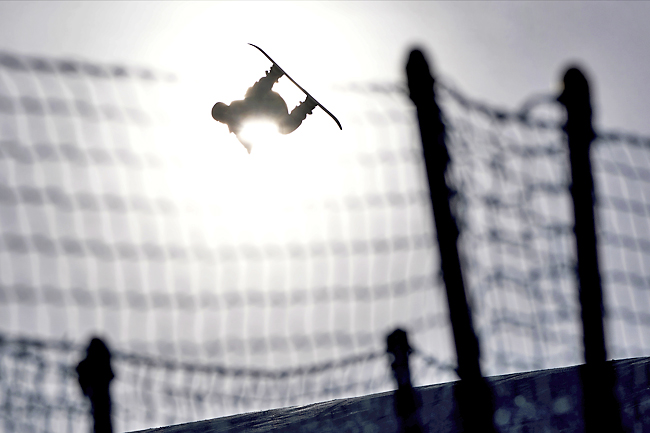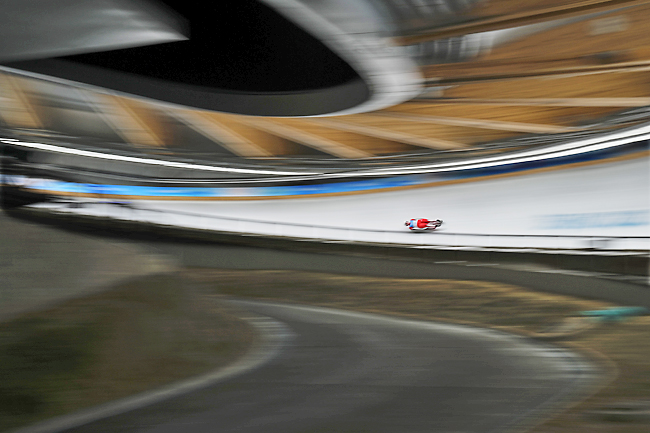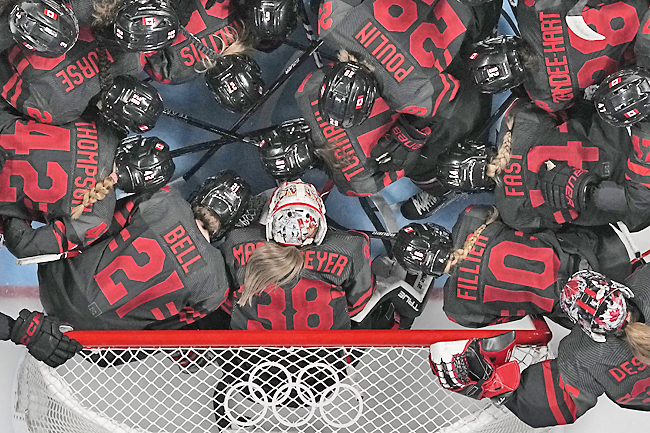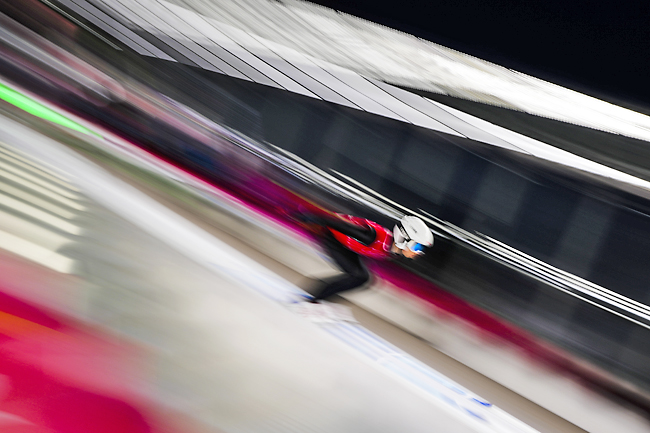BEIJING (AP) – A photograph is not a painting. A painting is not a photograph. Yet in the right situation, in the right hands, the two can approach each other and, in the best circumstances, seem to merge.
Add to that the unremitting scenes of dynamic motion that the Olympics provide – dramatic backdrops, unexpected moves, impossibly fit bodies performing at the height of their capacities – and you have a recipe for the arresting collision of news and aesthetics, of photography and art.
In short: Through the eyes and lenses of Associated Press photographers who are training their eyes on the arenas of competition at the Beijing Games, sometimes true magic can happen.
“Some of these photos, you can’t get around it, they look like paintings,” said Denis Paquin, who would know. He has overseen AP’s Olympic photo report for more than a decade and has viewed thousands of images over the past two weeks. Photography is sometimes called “painting with light”. With these images, that’s truer than usual.
So slow yourself down. Spend some time looking at these six images from the Beijing Winter Games and hearing from the photojournalists who made them. And think about what art is, what news is – and what photography can be when undertaken at the most thoughtful of levels.






THE SILHOUETTED SNOWBOARDER by Gregory Bull
What it shows: China’s Su Yiming competing during the men’s slopestyle finals last Monday.
Why it grabs you: Creates a dreamlike relationship between the sharply focussed snowboarder and the blurry mesh barrier, all backed by a blistering, blown-out sun. Has something of the elemental feel of a 19th-Century tintype – the world seen through a glass, darkly.
What Bull was thinking: “That frame took a while to make. I had been relying on very standard compositions for most of that day. Using the lovely fixtures of the slopestyle course, I would leave a spot for the athlete to perform, among the backdrop of the ice Great Wall or house. So for this picture I wanted to deconstruct, tear down my planned composition. I used the sun to kind of burn a hole in the middle of the picture, and let the snowboarder tear into the lines in the composition. With our cameras, the autofocus is amazing but it will track to lines, so I had to switch to manual, and prefocus at the distance where the snowboarder would fly into the frame. As luck would have it, the snowboarder also won a medal that day, which was also nice.”
THE SKATER IN THE RINGS by Ashley Landis
What it shows: Viktor Hald Horup of Denmark warming up during a light show before the start of the men’s speedskating 5,000-metre race on February 6.
Why it grabs you: The colours, so saturated and dappled with shadow and light. The dark grooves along the ice. Horup’s presence, smack in the middle of the red ring, caught mid-stride with his left leg in the air and his hand up, fingers visible. The diagonals, straight horizontal lines and circles that pull the image together. And the Beijing 2022 right in the middle of it all. The sense that this photo could stand in for the entire Winter Games.
What Landis was thinking: “It’s a really beautiful venue, but the light is very even all the way across. So it makes it very difficult to get artistic images, like silhouettes. However, before every session, there’s about a 30-second light show. And the first few days there there weren’t any skaters on the ice warming up during the light show and I was like, `Wouldn’t it be great if we had someone warming up and they could go across the logo across the rings?’ So I went out to the highest point that we can go to see the light show, hoping that someone would be on the ice warming up. Someone was, and they happened to go right through the rings at the perfect time.”
THE LUGE BLUR BY PAVEL GOLOVKIN
What it shows: Natalie Maag of Switzerland sliding during the luge women’s singles last Monday.
Why it grabs you: Scale, first of all — the tiny, sharply focused, brightly coloured athlete moving through a vast apparatus. The contrast of colours and the complementary curves that work with the blur to create a pleasing sense of motion.
What Golovkin was thinking: “You have to create more than simple pictures of athletes steering down the track, and one idea is to use a long shutter speed. It’s also good if your object of focus separates from the background not only by moving effect but by contrast as well. Natalie Maag’s brightly coloured suit helps with this.”
THE HOCKEY HUDDLE by Petr David Josek
What it shows: Canada’s players huddling before a women’s quarterfinal hockey game between Canada and Sweden on Friday.
Why it grabs you: The vantage point, of course. But also the painterly almost-symmetry anchored by the hockey net and ramped up by the red numbers and names on the black jerseys. Plus the contrast between the matte uniforms and the shiny black helmets – and the single white one.
What Josek was thinking: “Almost all teams huddle before each match and we take a photo of it using a remote overhead camera. Sometimes it works, sometimes it does not. I cropped this image tighter to get a bit different frame then in previous matches. Also, this time the Canadian ladies had their black uniforms, which I think really works in contrast with the white rings and the white goalie’s helmet.”
THE UPSIDE-DOWN SUN SEEKER by Francisco Seco
What it shows: Canada’s Mark McMorris competing during the men’s slopestyle qualifying on February 6.
Why it grabs you: Something feels off – in the best of ways – because of the athlete being upside down. The eye is drawn back and forth from the sun to the silhouette, and the entire frame feels frozen in time – even more than most photographs. It feels like a moment that could last forever.
What Seco was thinking: “I love silhouettes. Basically I was after this photo since we started covering snowboard. On that particular day, I shot the first round of qualifying from another position to secure one pic of each rider. Then I saw location of the sun and I thought it could be a good chance to try silhouettes. I moved to the right side of the track, just after the last jump. I roamed a bit before I found the good spot to shoot. Then I shot few riders during the second round. I was lucky with Mark McMorris. (I would really like to mention that our photo editor, Kiichiro Sato, did nice work editing it. So I would like to share with him any credit for the photo.)”
THE MOTION MACHINE by Matthias Schrader
What it shows: Matthew Soukup of Canada speeding down the hill during a men’s large hill training session on Thursday.
Why it grabs you: The diagonals. The splash of red in the corner that complements the middle of Soukup’s outfit. the jagged fragments around him, some sharp and some blurry. The utter sense of trajectory that the whole image conveys.
What Schrader was thinking: “I took this picture at the start on the ski jump tower. Besides the action pictures in the air and the landing, we also need some long time exposures and features to break up the photo galleries. That’s the moment, captured on a 16-35mm with 1/10 at f 5.6. Everything blurs a bit, and nice effects can be created.”






